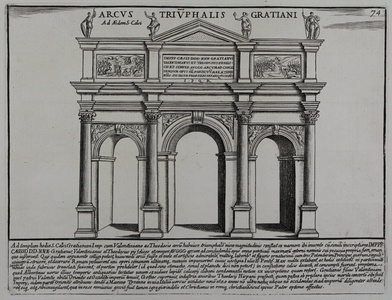| Method | Copper engraving |
| Artist | Domenico de' Rossi after Giacomo Lauro |
| Published | Cura, Sumptibus, ac Typis Dominici de Rubeis, Io: Iacobi hæredis ad Templum Sæ. Mariæ de Pace. Romæ, Anno MDCXCIX cum Privilo. Summi Pontis. et Lica. Super. [1699] |
| Dimensions | Image 141 x 228 mm, Plate 175 x 230 mm, Sheet 256 x 402 mm |
| Notes |
A depiction of the Arch of Triumph of Gratian, from Rossi's 'Romanae Magnitudinis Monumenta'. 'Romanae Magnitudinis Monumenta' was published in 1699 by the Roman book-dealer, printer, and antiquarian, Domenico Rossi. The work, a collection of plates designed to celebrate the architectural and archaeological achievements of ancient Rome, featured over 130 depictions of Roman temples, public buildings, amphitheatres, gardens, private villas, and monuments. Although unsigned, most of the plates were probably engraved by Rossi's friend and collaborator, Pietro Santi Bartoli. The majority of the views are actually re-engravings of an earlier series of Roman buildings published by the antiquarian Giacomo Lauro in 1612 in his 'Antiquae Urbis Splendor'. Lauro's original work was published in four parts. The first detailed Roman customs, with a brief history of the city and its hills and public buildings. The second and third enlarged upon this theme with further illustrations of Roman buildings and monuments, both public and private. The fourth presented a number of views of notable ruins, as well as images of Roman structures that had been reused in the present day, such as a the Villa d'Este at Tivoli and a particularly spectacular scene of a fireworks display at the Castel St Angelo. In most successive reprints though this fourth part was omitted, as it was in Rossi's 1699 edition, owing to the fact that Rossi and his audience were interested predominantly in Rome's storied past, rather than the churches, palazzi, and ruinous monuments of the present. Rossi later published a companion to the 'Romanae Magnitudinis Monumenta', called the 'Collectio Antiquitatum Urbis', in which the engravings from Lauro's fourth volume were combined with other views of the contemporary city, its cathedrals, churches, villas, and ruins. A number of Rossi's own views from this series would later be re-engraved and republished by Piranesi. Academically, the 'Antiquae Urbis Splendor' is significant for portraying the buildings as the artist believed they would have been at their peak, rather than as they appeared in their contemporary seventeenth century setting. Of particular note are a number of illustrations, which, while fanciful, attempt to depict monuments that by Lauro and Rossi's age had been completed erased from the archaeological record. Such depictions provide a fascinating glimpse at the breadth of seventeenth century knowledge of the Roman architectural past, and suggest that Lauro relied just as much upon descriptions of buildings in the classical text as he did the ruins of the structures themselves. Apart from providing some of the very earliest representations of Roman buildings, in many ways, men like Lauro and Rossi also pre-empted the detailed archaeological analysis championed by Piranesi and his followers a century later. Lauro's copious notes to his plates draw heavily from textual evidence, but, as he admits, he is less interested in rigid historical accuracy as he is evoking a sense of wonder for the Roman past. As a result, his Roman buildings are usually depicted isolated from their urban context. The effect at all times is one of an artist who is intensely proud of his Roman ancestry. Domenico de' Rossi (1659 – 1730) was an Italian publisher, engraver, bookseller, and antiquarian. The scion of a large and prolific family of printers, Domenico inherited the Rossi printshop from his father, Giovanni Giacomo de' Rossi. The printworks was established near the church of Santa Maria della Pace in 1633 by Guiseppe de'Rossi, who specialised in producing engravings for designers. Under Giovanni Giacomo and Domenico, the workshop reached its zenith, with father and son working on engravings on many diverse subjects, but with a speciality in publishing works of antiquarian interest. Domenico's friendship and collaboration with the engraver Bartoli and the antiquarian Bellori proved fruitful, and in the period between the early 1690s and Domenico's death in 1730, the group published numerous works on Roman architecture, sculpture, history, portraiture, ceramics, oil lamps, and funerary iconography. In Domenico's later life, his connections with the influential Maffei family secured the Rossi imprint Papal privilege. Following Domenico's death, the Rossi printshop became the Calcographia Camerale, then the Regia Calcographia, and finally the current Calcographia Nazionale. Giacomo Lauro (fl.1583 - 1645) was an Italian engraver, printmaker, antiquarian, and connoisseur, most famous for his 1599 perspective map of Rome, and the publication, between 1612 and 1628, of a series of views of Roman buildings called the 'Antiquae Urbis Splendor'. Very little is known of his life outside of these two works. He may be the son of another Giacomo Lauro of Treviso (1550-1605), though the fact that Lauro frequently signed his name as 'Jacobus Laurus Romanus' would suggest a Roman, rather than Trevisan, origin. Considering the rudimentary nature of many of the plates from his 'Antiquae Urbis Splendor', it would be easy to see Lauro as an engraver of only moderate talent, but his cartography, and the small number of portraits in his name indicate he was an artist of some skill. Instead, the 'Antiquae Urbis Splendor' should be seen as Lauro's attempt at producing a work that demonstrates his skill as an antiquarian and historian, the images intended to elucidate and educate. Condition: Slight paper buckling and some surface dirt. |
| Framing | unmounted |
| Price | £100.00 |
| Stock ID | 45130 |

